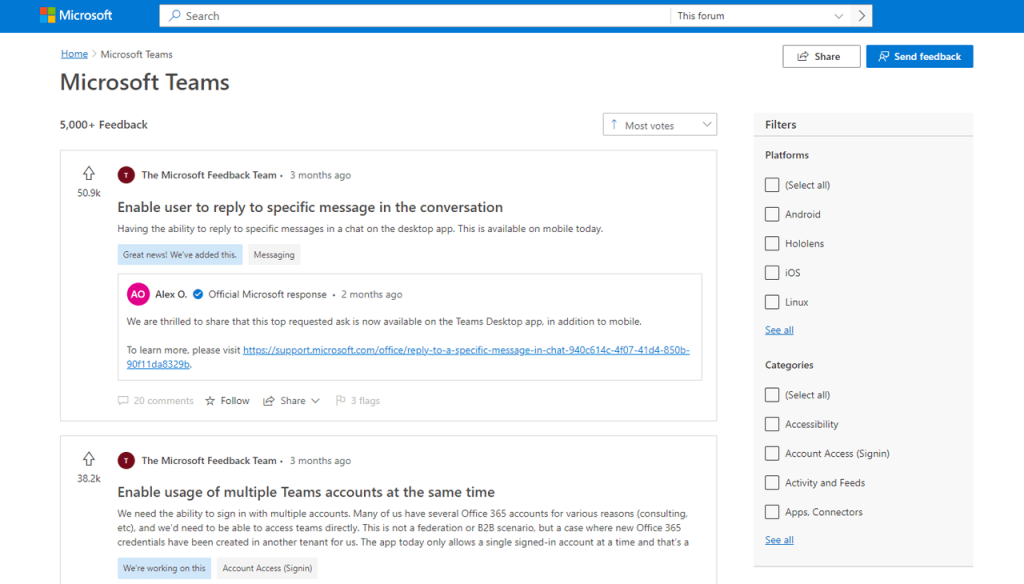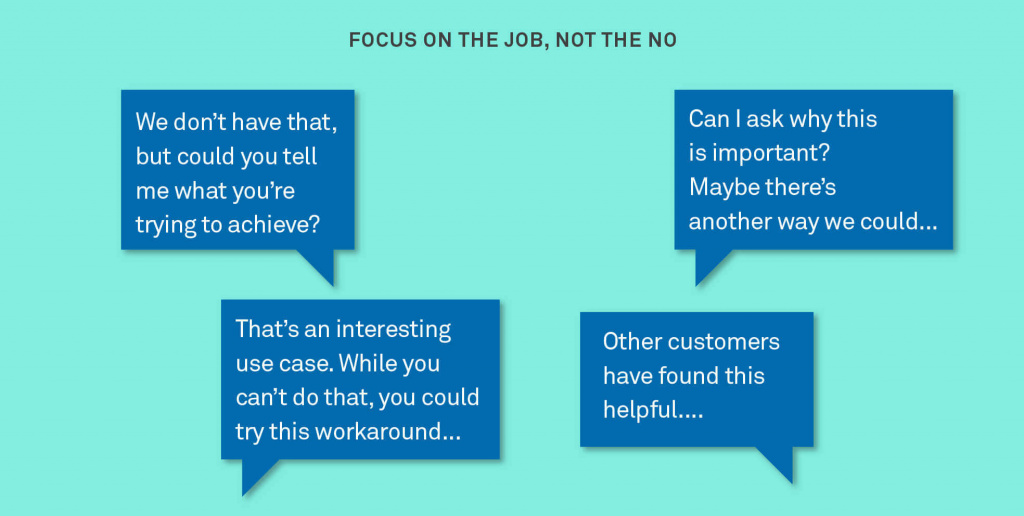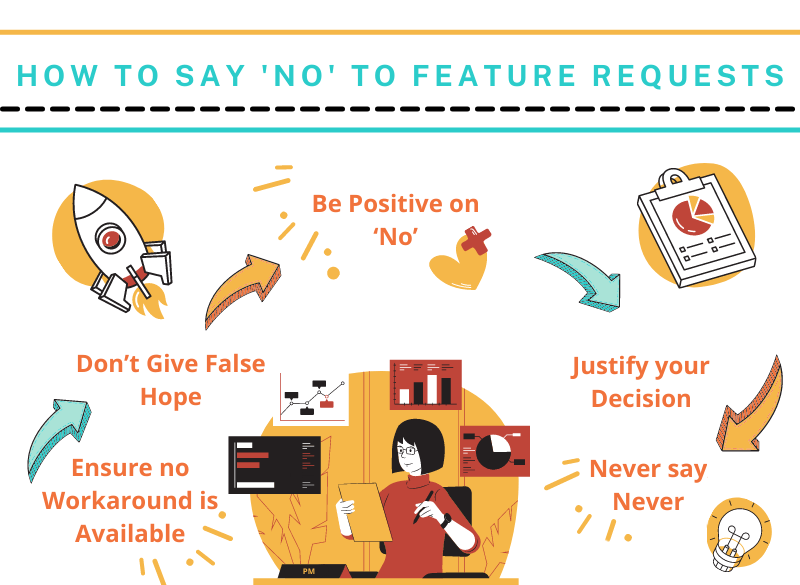Today there is a lot more interaction between customers and brands, especially what concerns SaaS companies. And one of the most frequent interactions is customer support and incoming feature requests.

Collecting Feature Requests
Businesses expect to receive some form of feedback and in fact, there are numerous reasons why customers also want to give it including the following (according to a whitepaper by TFM&A Insights):
- 64% of customers who give feedback want to express their opinion;
- 57% of customers are letting the brand know that it is performing badly;
- 49% want the brand to know it’s performed well and 32% want to thank the brand for the service;
- 13% of customers and 95% of Millennials are looking for a discount when giving their feedback.
There are numerous examples of how companies can organize flows and tools for collecting and managing user feature requests. Let’s take for example Microsoft. Their Feature Request Communities allow members to post ideas, upvote them, and comment on them.

Basically speaking, feature request board is a special portal where users can publish their ideas and others can upvote and comment, but it also involves the product development team in communications with end-users. By their example, Microsoft shows that open conversations with customers can bring great value to product development process. By making the request board and roadmap public, a company can crowdsource feature requests and see what the demand is like for a certain feature.
How to Say No To Feature Requests?
There are four typical scenarios when customers make a feature request:
- The feature is already in development and will be released at a future date;
- It is a new feature request that has not been thought of before and could be suitable for your product;
- The feature request already exists, and other users can upvote it;
- It’s a new feature request and you want to study the demand for it by collecting upvotes;
- This feature has been suggested/researched previously and was declined for some reason.
You shouldn’t be completely closed off to new feature suggestions. They might not meet your current vision for your product, but sometimes you can change your mind a couple of months later. Some features also might force you to change your vision. This isn’t always a bad thing and you should carefully consider new features that haven’t been explored yet.
However, not every feature that is requested meets your strategy and can be implemented. Sometimes a feature request is great but you don’t have the resources to implement it. Or it can take your product in a direction that you don’t want to head in. Or there could be issues with how the request will make the product work that isn’t compatible with current processes and flows.
This means that sometimes you have to turn to the customer and say “no” to them. This can be challenging. But there is a list of potential responses that you can offer. Here are some of those responses that you can give back.

1. Request Clarification of Customer Use Case
Sometimes customers can leave a feature request without any clarification. Therefore, you’ll need to request further information like how they envisage the feature will be used and helpful, and what is more important, find out the reason WHY they are requesting a certain feature, and elicit the underlying use case.
Here are some sample questions for clarification:
- What problem are you trying to solve with this feature?
- How do you manage it now?
Different customers actually may ask for different features to solve a similar problem. Don’t take everything as requests, try to think of it as feedback. The term “request” means you will do it because you have to, while feedback is constructive and you can use it as insights to figure out which problems your customers are having.
By requesting clarification you can also avoid disappointment. Sometimes customers aren’t clear on their objectives and what they request is not what they truly want. Therefore, when you make changes, the customer becomes disillusioned and states it isn’t what they wanted.
2. Show Respect for Customers’ Opinions and Thank Them for Their Time
Time is one of the most precious commodities that people have. Sometimes respecting a customer’s time is often a better selling point than other features. And two-thirds of customers want their opinion heard.
Therefore, you should show respect to your customers when they offer feedback or a feature request. Always thank them for their opinion and the time they’ve spent. This will go a long way to ensuring that a positive customer-brand relationship is maintained and let the customer know that you have received their feedback.
3. Stick to Your Product’s Vision
The next option is to state the vision that you’ve got for your product. You need to explain to your customers your strategy and the vision of your product. Who the main customers are and what their needs are. And you need to show that you know how your product adds value to the customer.
You should understand that your product delivers a certain value, and even if you don’t develop the changes your customers are asking for, your product will still continue to provide them value, and they will continue using it. There are no ideal products for all and will never be.
4. Ensure no Other Workaround is Available
The next stage is to ensure that no feature is currently available in the product that allows the customer to complete the task they want to do. This could be a manual option to get the result they want or a lesser-known feature that is included in the product currently released.
If there is something, create a detailed help article that can help your customer get the result they want.
For example, customer is asking for inbuilt translation tool:
Appologies, we currently don’t have that feature. We will see how popular this feature requests is among other customers by how many votes it receives.
In the meantime you can try using Google Chrome Translate plugin.
Let me know if you need anything else!
5. Justify Your Decision
You should be sure that you have a justification for why you’re saying no. This can be something similar like two systems are incompatible because of third-party rights. Or perhaps a feature will limit some of the other functions that are important to customers, or break some logic. Be strong in your justifications.
Many customers will respect your decision if there is a reason for this. Research has found that using a reason can increase compliance.
If you use the word ‘because’ in your response, you can increase compliance from 60% to 94%.
6. Don’t Give False Hope
You shouldn’t promise something to the customer that will never be implemented. They will look at every release to see if their suggestion has been implemented. It is better that you’re up-front and honest.
For instance, never promise to add a feature if you are not sure about it, always say that you will look into the matter. You should also never promise a specific timeline, like three months. Instead, state that you will create an update in the future to resolve a specific issue.
7. Tell You Will Study The Demand for That Feature
Before you decide if the use case is quite common, try to study it in more detail. Add the request to your feedback board to see how many other customers will upvote it and send a message like:
Thank you for your feedback! We’ve added your request to the feedback board: [link]. You will receive email updates as soon as the status of your request changes.
8. Be Positive on ‘No’
While ‘no’ might sound like you’re being negative, you don’t have to be. ‘No’ can be a positive step in a relationship. You can showcase how customers can use what you currently have to complete the same task or show them how future feature releases will result in better final output for the product.
This can show customers that you’re not saying ‘no’ because you don’t want the extra work to implement their feature request, but because you have a plan that is better for them.
9. Never Say Never
The next important thing to do is to always keep the door open for feature requests. Sometimes a feature is not suitable for your business today. That doesn’t mean that in two or three years that the feature won’t be more suitable for your brand.
Therefore, you can always say that you will keep their suggestion, and if it becomes more applicable in the future, you will consider it.
10. Don’t Feel Guilty About Saying ‘No’
Don’t forget that you can’t accept every feature request that is made and you shouldn’t. Your product should be under your control and feature requests are an important aspect. When you do have to say ‘no’, don’t let guilt seep in. Feel proud that you have strong control over your business.
11. Respond on a Timely Manner
Another important part is to ensure that you’re responding quickly. Even when you are not sure if you will take the request into development, update the customer and let them know, that you received their request. Oracle research has found that:
- 50% of customers expect an answer within 7 days;
- 43% of customers are angry if they don’t get a response within a week.

Feature Requests and Templates of How to Decline Them
When it comes to declining feature requests, knowing what to say can be challenging. There are certain rules and ways around negative responses that you can use these guidelines as examples.
Don’t say: Thank you for this feature request, but this is not something we plan to build.
Instead, respond with: We appreciate your message. Please could you tell us more about what you would like to achieve with this feature and why you are requesting it? Could you explain how this is important to you and the benefits you would like to gain?
Don’t say: We’re unconvinced that this feature is a good fit for us but will check with the development team.
Instead, respond with: Your suggestion and time are important to us but this feature is not supported at the moment. However, you can achieve the same results if you do X, add Y to your plan, or complete Z.
Don’t say: We would like to thank you for your time adding the feature request. However, at this time we are not adding new features to our product.
Instead, respond with: Thank you for your time. We understand why this feature is important to you. Other customers have been sharing their feedback regarding this as well. However, other priorities mean we are unable to add more features to the product right now. We’ll see how many upvotes this feature receives and will get back to it later.
Here is another example of a response that you can use when you would like to say ‘no’ to a feature request.
Hi [customer_name],
[Establish a positive tone for your response. You can remind the customer of the positive experiences they’ve had with your business. It can often be good to mirror their original quotes like ‘this is really great’.]
We understand that you would like to be able to [list action of requested feature].
[Show a positive reaction to the idea, but don’t be excited]
This would be a helpful feature and I’ve added it to a list of ideas [don’t use list of feature requests, or future improvements or bugs list]. We thank you for taking the time to share this idea with us.
[Now you need to say no but give an explanation]
When we choose which new features to add to our product development roadmap, we need to select the ideas that will add the greatest value to all our customers. We have a small development team and there are numerous tasks on our backlog.
You are the first person who has expressed an interest in [add feature], we will have to evaluate how popular this idea is among our audience and see how many upvotes it receives.
[add a positive spin to your product now]
Did you know there is a new cool feature that we’ve added to [product name]: [name new feature]. If you’ve yet to experience it, try and download the latest version of the product. And you can read more about the [feature] in this article.
We hope you have a great day!
[your signature]
Conclusion
Saying ‘no’ to customers’ feature requests is something that product development teams often have to do. After all, the ‘customer is always right’ statement is often mentioned. However, sometimes feature requests are not right for the product at least at a certain moment. Therefore, you have to learn how to say ‘no’ in a positive and polite way.
Using the techniques and templates above, you can determine how to say ‘no’ without losing current or potential customers.









